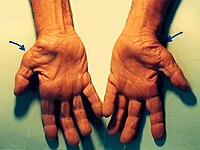
Photo from wikipedia
Background: Carpal Tunnel Syndrome (CTS) mainly affects adults of working age. The prevalence of severe cases is higher in elderly patients (>65 years old). Clinical guidelines recommend conservative treatment as… Click to show full abstract
Background: Carpal Tunnel Syndrome (CTS) mainly affects adults of working age. The prevalence of severe cases is higher in elderly patients (>65 years old). Clinical guidelines recommend conservative treatment as the best option in the initial stages of CTS to avoid severe cases. Diacutaneous Fibrolysis (DF) has demonstrated to improve nerve conduction studies and mechanosensitivity. The main purpose was to quantify changes in the cross-sectional area (CSA) of the median nerve, transversal carpal ligament (TCL) thickness, numbness intensity, and the subjective assessment of clinical change after DF treatment in patients with CTS. Methods: a double-blind, randomized, placebo-controlled trial was designed. A number of 44 patients (60 wrists) with CTS were randomized to the DF group or the sham group. CSA and TCL thickness variables were registered by ultrasound. Clinical variables were assessed by the visual analogue scale and GROC scale. SPSS version 24.0 for MAC was used for statistical analysis. The group by time interaction between groups was analyzed using two-way repeated measures analysis of variance. Results: The DF group reduced CSA with a mean of 0.45 mm2 (IC 95% 0.05 to 0.86) and TCL thickness with a mean reduction of 0.4 mm (IC 95% 0.6 to 2.1) compared to the sham group (p < 0.01, p < 0,03, respectively). Additionally, the DF group decreased the numbness intensity with a mean reduction of 3.47 (IC 95% 2.50 to 4.44, p < 0.01) and showed a statistically significant improvement on the GROC scale (p < 0.01). Conclusions: DF treatment may significantly reduce CSA and TCL thickness, numbness intensity, and improved clinical perspective. DF applied in patients with mild to moderate CTS may prevent the progression of the disease as they age.
Journal Title: International Journal of Environmental Research and Public Health
Year Published: 2022
Link to full text (if available)
Share on Social Media: Sign Up to like & get
recommendations!